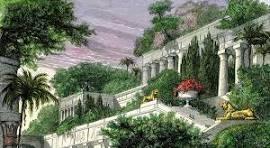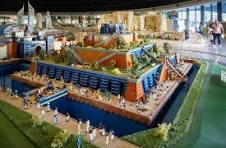But I’m only bothered about the Iraqi one, as not only is it The Hanging Gardens of Babylon but it is also in what was known as Mesopotamia which is my favorite historical place and time for all sorts of reasons.
By about 3000 BCE its peoples had developed cities and a writing system. Evidence for their gardens comes from written texts, pictorial sculpture, and archeology. For instance at Mari in about 1,800 BCE the inner and outer defensive walls were circular and it is thought that the land between the walls was used for gardens. It was normal for Mesopotamian gardens to be planted with date palms beneath which fruit trees and vegetables were grown. Mari is 150 miles upriver from Babylon.
Hanging Gardens of Babylon - artist's impression
One of the oldest mentions of the Hanging Gardens is attributed to the 3rd century BCE Babylonian priest Berossus. Original writings from Berossus haven’t survived, but Laurie Pearce, an Assyriologist at the University of California, Berkeley, says that his works were quoted by Greek historians. The 1st century Roman historian Flavius Josephus quoted Berossus talking about Babylon having walls with hanging gardens, paradise with plenty of different species of trees.The most popular story about the Hanging Gardens involves the Babylonian, King Nebuchadnezzar II, and his queen Amytis: “Nebuchadnezzar rendered the prospect an exact resemblance of a mountainous country. This he did to gratify his queen, because she had been brought up in Media, and was fond of a mountainous situation”.The lack of any solid archaeological evidence has led some scholars to believe that the gardens didn’t exist at all, that they were merely a figment of ancient Greek minds and lore. But some scholars are dismissive of this take:“That’s a pretty stupid copout really,” says Stephanie Dalley, an Assyriologist the University of Oxford. “It doesn’t make sense to say we couldn’t find it, so it didn’t exist.”Dalley believes the Hanging Gardens of Babylon were actually the Hanging Gardens of Nineveh — an Assyrian city sometimes called Babylon in historical texts.Recent excavations have found traces of aqueducts. One near Nineveh was so vast that Dalley said its remains looked like a stretch of motorway from the air, and it bore a crucial inscription: "Sennacherib king of the world … Over a great distance I had a watercourse directed to the environs of Nineveh …"Dalley said: "That the Hanging Garden was built in Babylon by Nebuchadnezzar the Great is a fact learned at school and … 'verified' in encyclopaedias … To challenge such a universally accepted truth might seem the height of arrogance, revisionist scholarship ... But Assyriology is a relatively recent discipline … Facts that once seemed secure become redundant."
Sennacherib's palace, with steps of semi-precious stone and an entrance guarded by colossal copper lions, was magnificent. Dalley pieced together ancient texts to reveal a garden that recreated a mountain landscape. It boasted terraces, pillared walkways, exotic plants and trees, and rippling streams.

Hanging Gardens of Babylon - in Lego
Little of Nineveh – near present-day Mosul – has so far been explored, because it has been judged too dangerous to conduct excavations.And these are the Seven Wonders of the World:The Great Pyramid of Giza, the Colossus of Rhodes, the Lighthouse of Alexandria, the Mausoleum at Halicarnassus, the Temple of Artemis, the Statue of Zeus at Olympia, and the Hanging Gardens of Babylon.There does not seem to be any decent poems about The Hanging Gardens of Babylon. Which seems odd. So, I used Garden as a subject and found this haiku by Bashō:
winter garden
the moon thinned to a thread
insects singing
translated by Robert Hass
Thanks for reading, Terry Q. Email ThisBlogThis!Share to TwitterShare to Facebook
